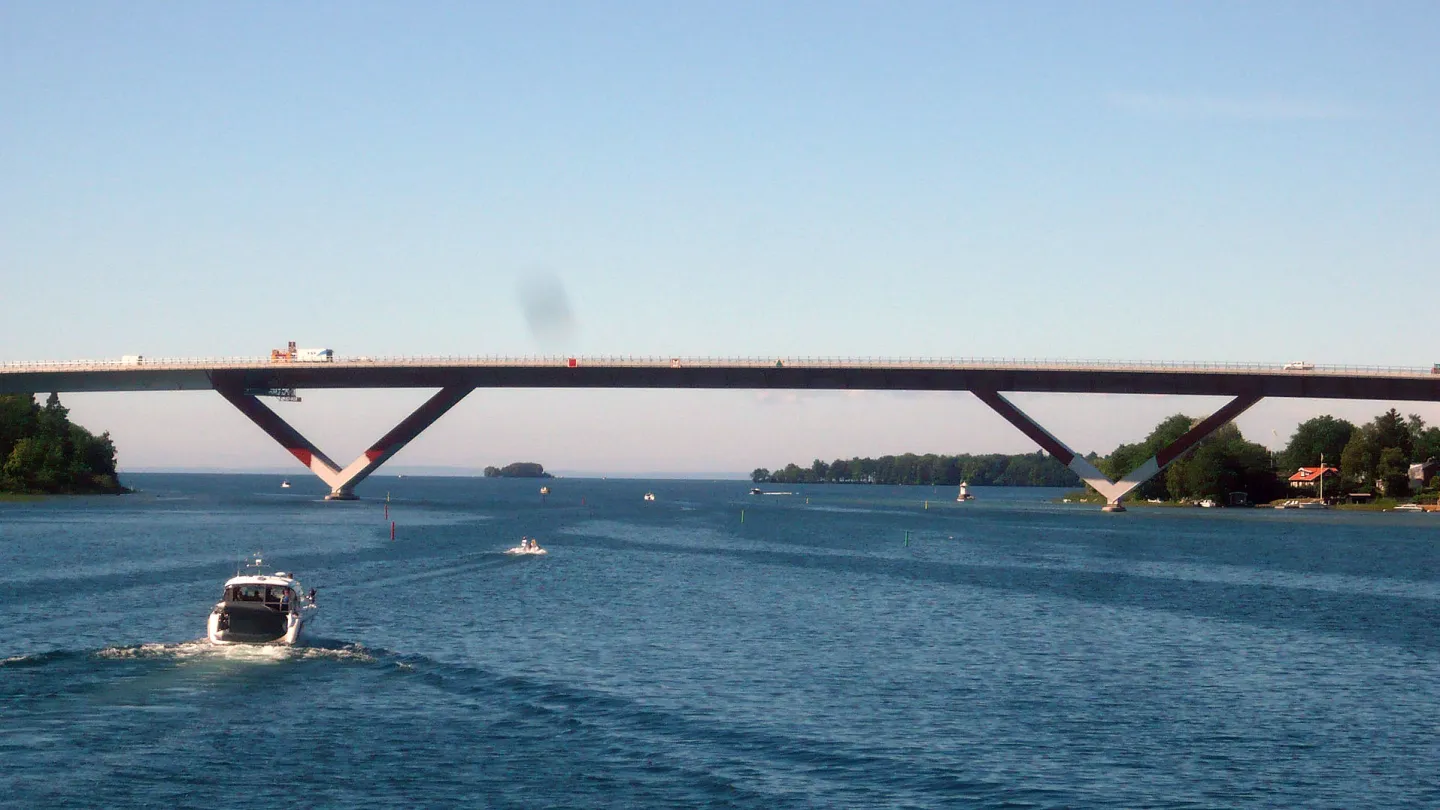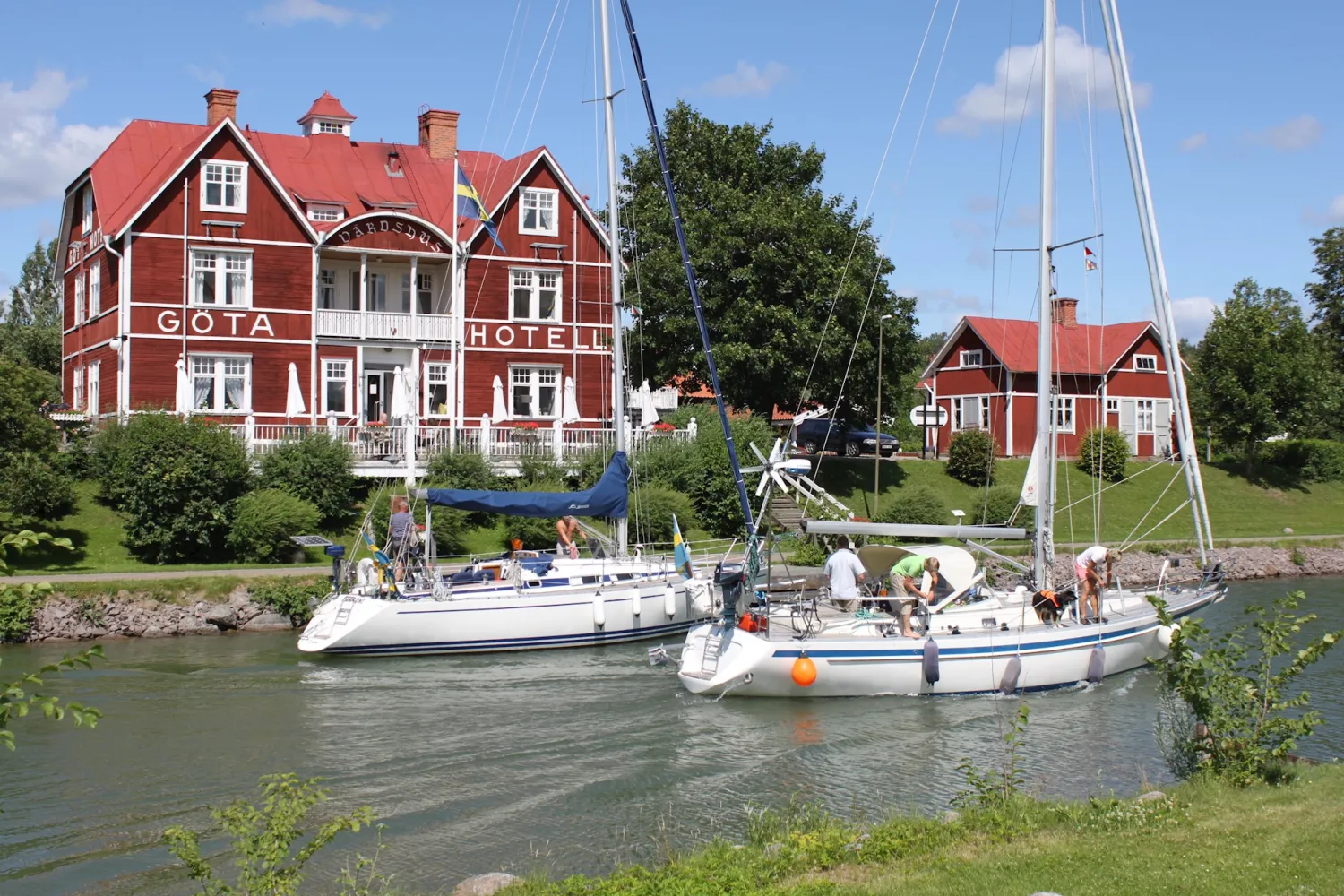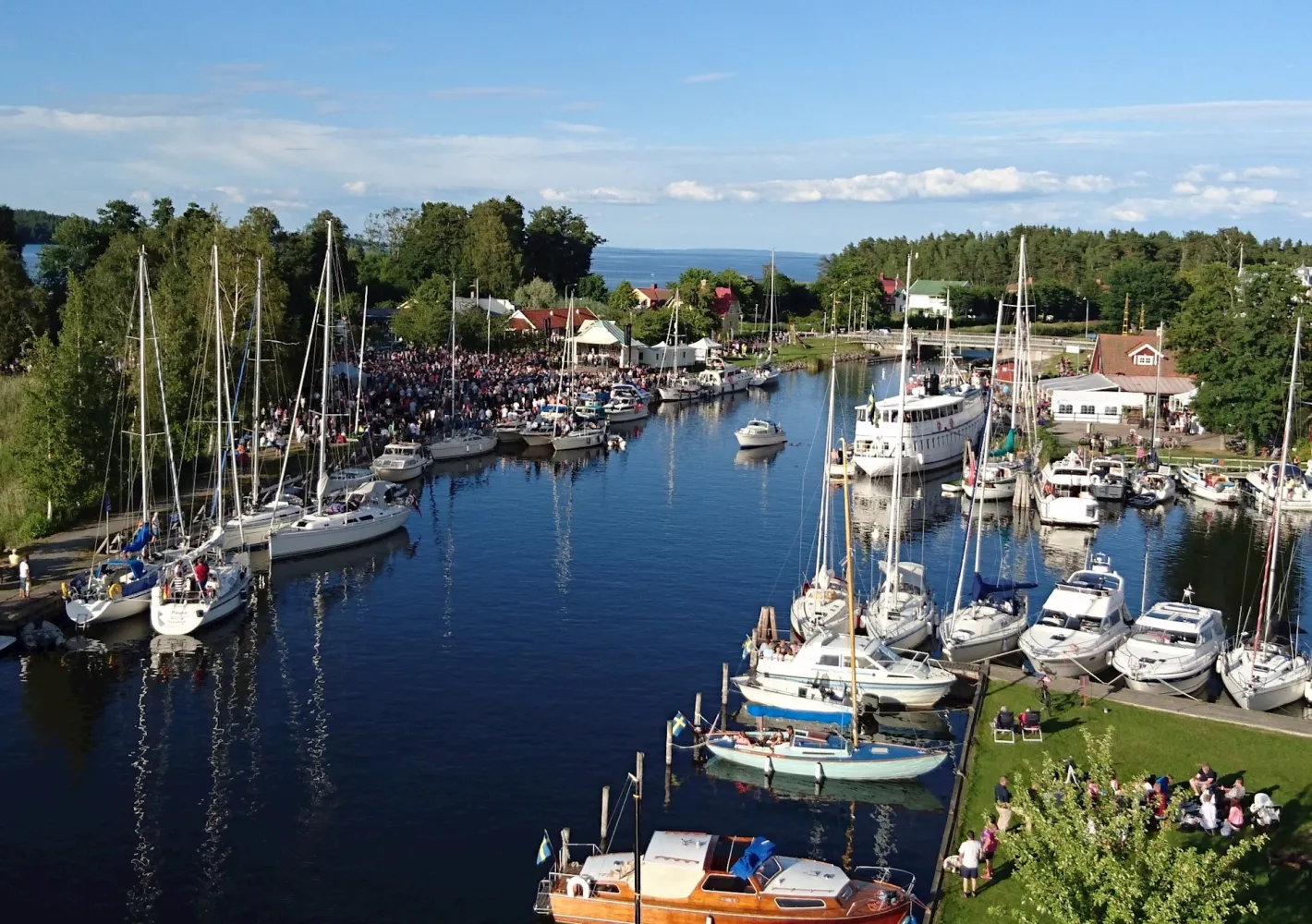Tips on harbours and destinations on Lake Vättern
The unique lake Vättern is known for its clean and crystal clear water. Here there are long white beaches, steep cliffs that rise like walls out of the water and an archipelago with hundreds of islets and skerries. The average depth is 40 metres and the visibility depth up to 15 metres. The weather is often good and contributes to the lush vegetation, but it can change quickly and often without warning.
There are many reasons to stay at Lake Vättern and extend your stay along the Göta Canal. Whether you choose to turn around here, or just want to make a detour during the canal journey, there is plenty to see and experience.
Have you not booked your Göta Canal ticket yet? Then you can do it right now, or you can read more about how a canal trip works.
The Valekleven-Ombo Islands
The archipelagic atmosphere appears gradually, little by little, already about ten nautical miles north of Karlsborg. There are Ombo islands, a lagoon-like paradise with very clear water. The five mountainous islands have a dramatic appearance, with irregular shoreline contours and vertical rocks running down into the water. Here you will find natural harbours in the form of bays and lagoons with muddy bottoms, and several nice bathing spots. The bays that are open to the winds can, however, have pebble bottoms. The islands are dominated by up to 300-year-old and partially old-growth, flat rock pinewood forest with a reindeer lichen cover. Just like on many of the other islands in the northern archipelago, there are rubbish bins here so you can easily dispose of your rubbish.
The area between the Ombo islands and the mainland is called Djäknesundet. Here, too, flat rock pinewood dominates on the rock formations that jut out into Lake Vättern. The terrain is highly rugged with many opportunities to swim from the rocks or the sandy beach where the Djäknebäcken stream runs into the lake.
Kyrkogårdsön (Cemetery Island)
A few nautical miles north-northwest of the Ombo islands, there is an area with a slightly eerier history. Kyrkogårdsön, which got its name after the Black Death Plague in the 14th century. In an attempt to escape the plague, a number of people took refuge on this island, but eventually the plague came here too, and they all died one by one. Today there is a memorial for the dead as well as remains of a stone wall that surrounded the cemetery. Despite the name, Kyrkogårdsön is very beautiful. It is also the home of an excellent and well-protected natural harbour, which is either reached via Dödssundet in the south or via Svartsundet in the north. But the entrances are tight, so be wary of the shoals.
Stora Röknen
Directly east of Kyrkogårdsön lies Stora Röknen, a large sandstone island resting on a mountain ridge. As the island is in the middle of Lake Vättern, it divides the lake into two deep water basins. Remains found here show settlement as early as the Stone Age. On the sister island of Röknehuvud, Russian deserters and prisoners of war worked in the early 1800s to quarry sandstone for the construction of the Göta Canal. There is still a large barracks house where the prisoners lived. In 1949, the military took over Stora Röknen and the permanent residents, though reluctant, had to move. The island is still used as a military training ground and there is a disembarkation ban.
Askersund and the northern Vättern archipelago
In the far north you will find one of Europe's largest inland archipelagos. The northern Vättern archipelago nature reserve consists of around fifty islands and thousands of islets and skerries. Apart from two small homesteads on Stora and Lilla Aspön, however, the archipelago has never been inhabited. The reserve is a wilderness archipelago where only the majestic birds of prey, the hobby and the osprey, are permanent residents in any real sense. Some islands have rough-hewn rocks, and others smoothly polished slabs of granite. All of them are "clothed" in windswept pine forest where they spread out with the blue-green, glistening water of Lake Vättern in the foreground.
You can decide whether you want to dock secluded on "your own" islet, or come together with other boating families in the most popular natural harbours. Grönön is a beautiful island surrounded by many small islets and islands. On the main island itself there is a jetty on the west side where even larger boats can dock, as well as several beautiful natural sites at which to moor around the island. There are also nice barbecue areas and toilet facilities here.
When supplies run low, you are close to Askersund. A sail of seven or eight nautical miles takes you to the cosy little town, where you can stock up on both food and beverage supplies, or refuel and refill water. Askersund also has a marina, but it's a bit tricky to find, so ask around!
Sandön
A few nautical miles to the south is an area with an amazing sandy bottom. The water depth varies from a few metres to five or six metres, but with a little caution and a lookout, it is possible to make your way there safe and sound. It goes without saying that the largest island is called Sandön. The other small islands look almost atoll-like as they lie embedded in turquoise waters. Here it is lovely to just lie and snorkel in the clear water.
The hermit of Fjuk
Perhaps you have heard of "the hermit of Fjuk" at some point. His real name was Erik Zetterblad and is said to have worked as an engineer at a mechanical workshop. Exactly why he settled on Fjuk is not known, but once there he stayed for a full 52 years on his island until he passed away in 1966.
Fjuk, which is located almost exactly halfway between Motala and Karlsborg, actually consists of three islands, between which you can walk without wetting your shoes, at low tide. In the bay between two of the islands are the remains of a port, and on the lake bed just outside the port lies the Byälven, a cargo steamer that sank at the site in 1936.
When you stand on Fjuk, it is somewhat surprising to think that in the 1880s there were actually 17 people living here, and that there was even a school. But in connection with the automation of the lighthouse in the early 1890s, the island was depopulated.
Vadstena
Vadstena has a very particular, almost magical atmosphere. It may be due to the medieval settlement, the presence of Lake Vättern, the beautiful landscape of the Östergötland plain, or the locals' pride in their place. But it is a feeling that must be experienced. Viewed from the lake, the city's silhouette does not differ much from how it looked in the Middle Ages. In clear weather, the monastery is a highly visible landmark from afar. It is also called the Blue Church, as it appears to be a shade of blue when viewed at a distance. The monastery was designed by Saint Birgitta in the 14th century and even today you can meet nuns on the streets of Vadstena, though they now live in a slightly more modern monastery across the street.
In addition to all the history, Vadstena is a really lovely summer town, well worth a visit. The spectacular guest harbour is partly located in the moat around the best-preserved Renaissance castle in the Nordics, Vadstena Castle. Here you are well protected under most weather conditions and mooring is done according to the port master's instructions.
Hjo
Hjo is a small forestry town on the western shore of Lake Vättern. The harbour is located in the heart of the city, and during the summer months it is a place full of life and activity. Here you will find the family-friendly Gruldkroksbadet, which is a free swimming bath with heated outdoor pools, a sandy beach and changing stalls. Within walking distance there are also eateries, cafes, grocery stores and cosy little shops.
Gränna
The beautiful town of Gränna was founded by Per Brahe almost 400 years ago. Located on the shores of Lake Vättern, it is surrounded by nature reserves with deep and magical forests that inspired many of John Bauer's fairy tales. It is very much a place where you can feel the air of history, experience beautiful surroundings and stroll around a small town brimming with life. Down by the harbour you can enjoy food and ice cream, and see the ferry travelling to and from Visingsö. On lovely summer evenings, you can also experience a fantastic sunset.
Today, Gränna is best known for being home to a number of makers of polkagris candy, each with their own unique take on the striped peppermint candy, a Swedish classic. It all began all the way back in 1859 when single mother, Amalia Erikson received permission to open a sugar bakery in order to support herself and her daughter, through the production of "finer pastries and the so-called polkagris". These were initially called "pluttar", but after a while Amalia launched the polkagris candy cane, which became a hallmark of Gränna - and one of Sweden's most popular souvenirs!
Visingsö
The southern part of Lake Vättern does not at all have the same island-rich archipelago as in the north. Instead, Vättern's largest island, Visingsö, dominates here. According to legend, Visingsö was created when the mythical giant Vist threw a tuft of grass into Lake Vättern so that his old lady would have something to step on. Here you can enjoy historical remains, beautiful environments, art and much more!
If you want to feel the beating wings of history, there are local stories about everything from royal murders, prisoners of war and the time when Sweden was ruled from Visingsö. Start by sailing to the ferry quay on the island and discover the exciting Visingborg Castle, before sailing further down towards Näs and the ruins of Sweden's first national castle. By the harbour you can buy smoked fish to eat on the pier, or go for a ride in one of the island's popular horse-drawn carriages. If you can muster the courage to climb the dizzying stairs of Kumlaby church, you will be rewarded with a wonderful view of both the island and the lake.
Jönköping
Farthest to the south is Jönköping with a fairly new harbour and a 160 metre quay along the outer harbour pier. Jönköping is sometimes called the City of Matches, because of the success the Jönköping Match Factory had with its safety matches at the end of the 19th century. In its heyday, the city had no less than five match factories. Today you can visit the old matchstick district about 500 metres from the harbour.
Travelling on Lake Vättern means travelling long distances, keep this in mind when planning your trip. The lake spans 70 nautical miles from north to south and the fueling stations are relatively few. However, there is plenty of water, Vättern is a spring lake, almost 130 metres in depth and one of Sweden's cleanest lakes by far. Almost fifty thousand households take their water directly from the lake, so you can help yourself too.


